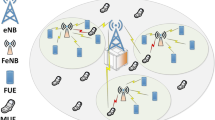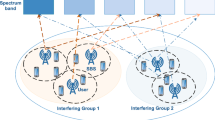Abstract
In heterogeneous cellular networks (HCNs), the deployed small cell base stations share the same spectrum resource with that of macro base station, which causes cross-tier interferences and the performance depreciation of the system. This paper investigates the downlink outage performance of HCNs and its resource allocation problem to mitigate interferences. Specifically, we first derive closed-form expressions of overall outage probability of the system. Then, the resource allocation problem is proposed to reduce the outage probability of HCNs. This problem is formulated as a matching game, and a stable matching is considered to be the solution. Finally, to address this matching problem, a distributed algorithm is proposed which can find a stable matching. Both analytical results and simulations show that the proposed algorithm improves the overall performance of HCNs.






Similar content being viewed by others
References
López-Peérez, D., et al. (2011). Enhanced intercell interference coordination challenges in heterogeneous networks. IEEE Transaction on Wireless Communications, 18(3), 22–30.
Prehofer, C., & Bettstetter, C. (2005). Self-organization in communication networks: Principles and design paradigms. IEEE Communication Magazine, 43(7), 78–85.
Dai, H., Huang, Y., & Yang, L. (2015). Game theoretic max-logit learning approaches for joint base station selection and resource allocation in heterogeneous networks. IEEE Journal Selected Areas in Communications, 33(6), 1–14.
Gale, D., & Shapley, L. S. (1962). College admissions and the stability of marriage. The American Mathematical Monthly, 69(1), 9–15.
Escoffier, B., Gourvès, L., & Monnot, J. (2016). The price of optimum: Complexity and approximation for a matching game. Algorithmica, 1–31.
Bando, K., Kawasaki, R., & Muto, S. (2016). Two-sided matching with externalities: A survey. Journal of the Operations Research Society of Japan, 59(1), 35–71.
Bi, S., Zhang, R., Ding, Z., et al. (2015). Wireless communications in the era of big data. IEEE Communications Magazine, 53(10), 190–199.
Gu, Y., Saad, W., Bennis, M., et al. (2015). Matching theory for future wireless networks: fundamentals and applications. IEEE Communications Magazine, 53(5), 52–59.
Touati, M., Azouzi, R. E., Coupechoux, M., et al. (2015). Controlled matching game for user association and resource allocation in multi-rate wlans. arXiv preprint arXiv:1510.00931.
Abedin, S. F., Alam, M. G. R., Tran, N. H., et al. (2015). A fog based system model for cooperative IOT node pairing using matching theory. In 2015 17th Asia-Pacific Network Operations and Management Symposium (APNOMS), pp. 309–314.
Namvar, N., & Afghah, F. (2015). Spectrum sharing in cooperative cognitive radio networks: A matching game framework. In 2015 49th Annual Conference on Information Sciences and Systems (CISS), pp. 1–5.
Song, K., Ji, B., Huang, Y., et al. (2015). Performance analysis of antenna selection in two-way relay networks. IEEE Transaction on Signal Processing, 63(10), 2520–2532.
Xu, W., Liang, L., Zhang, H., et al. (2012). Performance enhanced transmission in device-to-device communications: Beamforming or interference cancellation? In 2012 IEEE Global Communications Conference (GLOBECOM), pp. 4296–4301.
Ni, Y., Jin, S., Xu, W., et al. (2016). Beamforming and interference cancellation for D2D communication underlaying cellular networks. IEEE Transaction on Communications, 64(2), 832–846.
Luo, H., Li, W., Zhang, Y., et al. (2016). CRS interference cancellation algorithm for heterogeneous network. Electronics Letters, 52(1), 77–79.
Nauryzbayev, G., & Alsusa, E. (2016). Enhanced multiplexing gain using interference alignment cancellation in multi-cell mimo networks. IEEE Transaction on Information Theory, 62(1), 357–369.
Niu, Q., Zeng, Z., Zhang, T., et al. (2014). Joint interference alignment and power allocation in heterogeneous networks. In 2014 IEEE 25th Annual International Symposium on Personal, Indoor, and Mobile Radio Communication (PIMRC), pp. 733–737.
Zhang, H., Jiang, C., Mao, X., et al. (2016). Interference-Limited Resource Optimization in Cognitive Femtocells with Fairness and Imperfect Spectrum Sensing. IEEE Transactions on Vehicular Technology, 65(3), 1761–1771.
Almalfouh, S. M., & Stuber, G. L. (2011). Interference-aware radio resource allocation in OFDMA-based cognitive radio networks. IEEE Transactions on Vehicular Technology, 60(4), 1699–1713.
Chandrasekhar, V., Andrews, J. G., Muharemovic, T., et al. (2009). Power control in two-tier femtocell networks. IEEE Transactions on Wireless Communications, 8(8), 4316–4328.
Zhang, H., Jiang, C., Beaulieu, N. C., et al. (2015). Resource allocation for cognitive small cell networks: A cooperative bargaining game theoretic approach. IEEE Transactions on Wireless Communications, 14(6), 3481–3493.
Zhang, H., Jiang, C., Beaulieu, N. C., et al. (2014). Resource allocation in spectrum-sharing OFDMA femtocells with heterogeneous services. IEEE Transactions on Communications, 62(7), 2366–2377.
Zhao, R., Huang, Y., Wang, W., & Lau, V. K. N. (2016). Ergodic achievable secrecy rate of multiple-antenna relay systems with cooperative jamming. IEEE Transactions on Wireless Communications, 15(4), 2537–2551.
Wang, Y., Ji, B., Huang, Y., et al. (2016). Analysis over spectral efficiency and power scaling in massive MIMO dual-hop systems with multi-pair users. IEICE Transactions on Fundamentals of Electronics, Communications and Computer Sciences, 99(9), 1665–1673.
Jeffrey, A., & Zwillinger, D. (2007). Table of integrals, series, and products. Cambridge: Academic Press.
Namvar, N., Saad, W., & Maham, B. (2015). Cell selection in wireless two-tier networks: a context-aware matching game. arXiv preprint arXiv:1512.00539.
Acknowledgements
This work was supported by the National High Technology Research and Development Program of China (863 Program) under Grants 2015AA01A703 and 2014AA01A704, the Research Project of Jiangsu Province under Grants BK20130019 and BE2015156, the National Natural Science Foundation of China under Grants 61372101, 6153101, 61671144 and U1404615, the Open Funds of State Key Laboratory of Millimeter Waves under Grant K201504, China Postdoctoral Science Foundation under Grant 2015M571637, the natural science research project of universities in Jiangsu Province under Grant 16KJB510008, the Natural Science Foundation of State Grid Corporation of China under Grant 2015-0615-2298, and the Scientific Research Foundation of Graduate School of Southeast University under Grant 3204006707.
Author information
Authors and Affiliations
Corresponding author
Rights and permissions
About this article
Cite this article
Dai, H., Song, K., Li, C. et al. Resource allocation for outage performance in heterogeneous networks: a matching game approach. Wireless Netw 24, 1873–1883 (2018). https://doi.org/10.1007/s11276-016-1438-1
Published:
Issue Date:
DOI: https://doi.org/10.1007/s11276-016-1438-1




